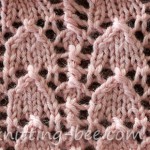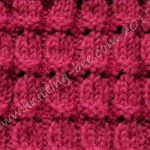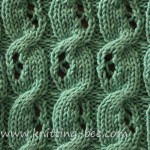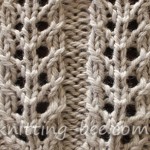Open Chain Ribbing free Knitting Stitch.
This stitch pattern produces a surprisingly airy and textured fabric, despite its “ribbing” designation. It creates a series of interconnected, open “chains” that run vertically along the fabric, separated by columns of garter stitch. The chains are formed through a clever sequence of yarn overs, slipped stitches, and decreases, resulting in a fabric that is both visually intriguing and structurally unique. Unlike traditional ribbing, which is known for its elasticity, this Open Chain Ribbing has a more open and less stretchy structure, making it ideal for projects where drape and visual interest are prioritized over snugness. It’s a fantastic choice for lightweight shawls, scarves, or decorative panels.

The core of the Open Chain Ribbing lies in the interplay of increases and decreases. The yf twice in Row 2 creates two yarn overs, which are then carefully worked in Row 3 to form the open “links” of the chain. The sl 1, k1, psso and k2tog combinations work in conjunction with the yarn overs to maintain the stitch count and shape the chain links. Row 4 mirrors this process, with the placement of yarn overs and the psso, and k2tog. These four rows combine to build the effect of chains of ribbing running up the pattern.
Abbreviations:
- K: Knit
- P: Purl
- Sl: Slip stitch purlwise (as if to purl, but without working the stitch)
- St(s): Stitch(es)
- K2tog: Knit two stitches together (a decrease)
- Yf: Yarn forward (bring the yarn to the front of the work, between the needles)
- Yo: Yarn over.
- psso: Pass slipped stitch over.
- WS: Wrong Side.
Cast On:
Multiple of 6 + 2.
Knitting Directions:
Row 1 (WS): K2, *p4, k2; rep from * to end.
Row 2: P2, *k2tog, yf twice, sl 1, k1, psso, p2; rep from * to end.
Row 3: K2, *p1, purl into front of first yf, purl into back of 2nd yf, p1, k2; rep from * to end.
Row 4: P2, *yo, sl 1, k1, psso, k2tog, yf, p2; rep from * to end.
Rep these 4 rows.







